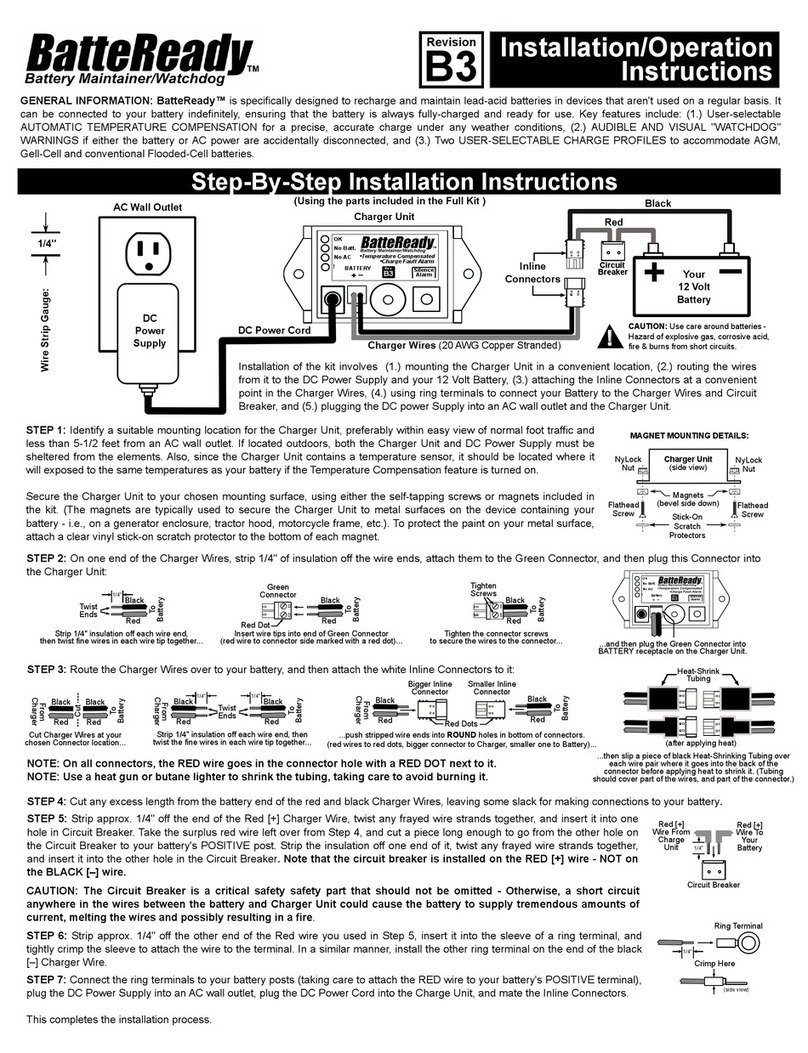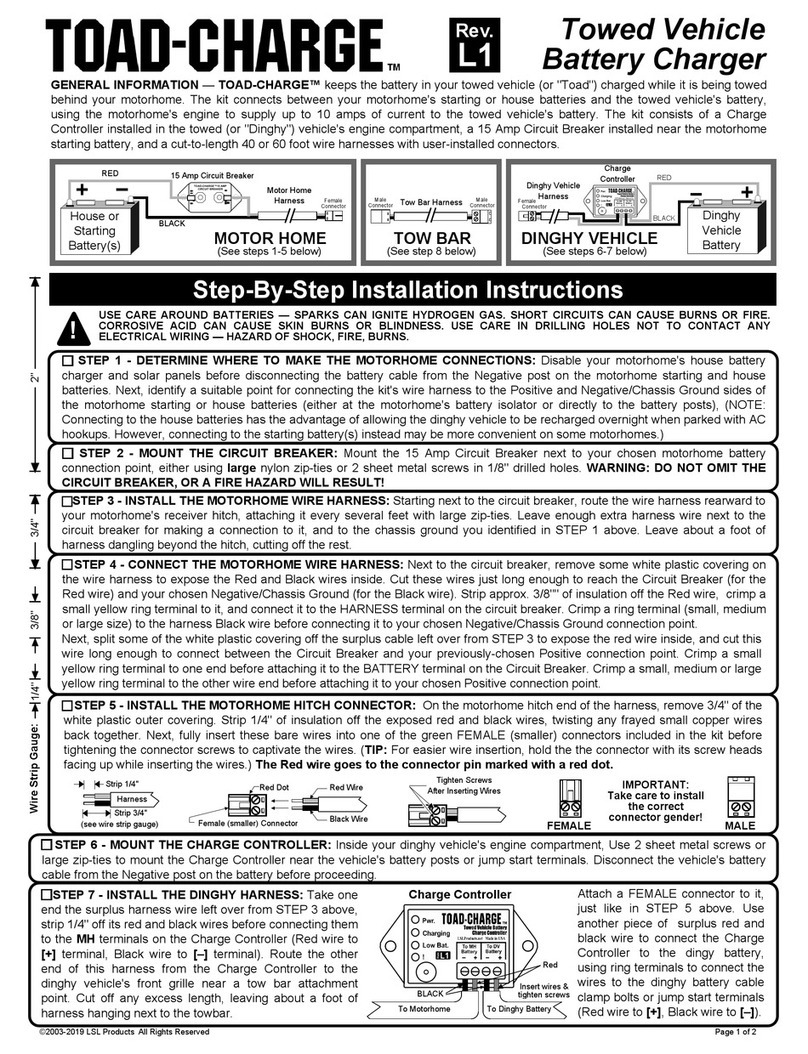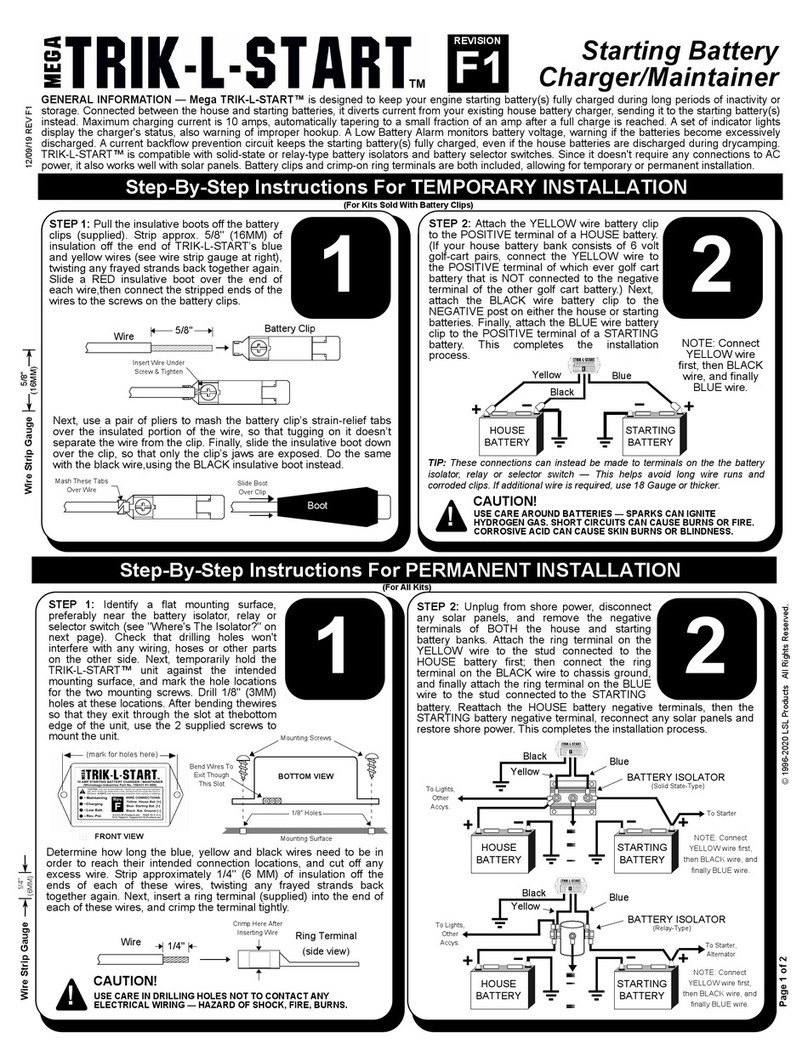
Towed Vehicle
Battery Charger
STEP ONE: For safety's sake, disable your house battery charger and solar panels before disconnecting the battery cable from the Negative
post on the motorhome starting and house batteries. Next, identify a suitable point for connecting the kit's wire harness to the Positive and
Negative/Chassis Ground sides of your motorhome's starting or house batteries (either at your motorhome's battery isolator or directly to the
battery posts), but don't connect the wires yet. (NOTE: Connecting the harness to the motorhome's HOUSE batteries has the advantage of
allowing the towed vehicle to be recharged overnight when parked with AC hookups.) Route the harness rearward to your motorhome's
receiver hitch, using the Nylon Wire Ties (included in the kit) as the means of attachment every few feet or so. Take care to keep the harness
from touching hot exhaust parts, sharp edges or moving parts of the motorhome drivetrain. After you reach the hitch at the back of the motor
home, cut off any surplus wire, leaving about a foot of harness dangling beyond the hitch. Save the surplus wire for use in STEP TWO below.
GENERAL INFORMATION — TOAD-CHARGE™ keeps the battery in your towed vehicle (or "Toad") charged while it is being towed behind your motorhome, thereby
solving the battery discharge problems often caused by auxiliary braking systems or leaving the steering wheel unlocked while towing. The kit connects between your
motorhome's starting or house batteries and the towed vehicle's battery, using the motorhome's engine to supply up to 10 amps of current to the towed vehicle's battery.
The kit consists of several components: A Charge Controller installed in the towed (or "Dinghy") vehicle's engine compartment monitors the charging current, and
prevents reverse current flow when the motorhome engine is started. A 15 Amp Circuit Breaker installed near the motorhome starting battery protects against excessive
current flow due to wiring faults or a dead battery. The Charge Controller and Circuit Breaker are connected together by wire harnesses which are cut to desired lengths
from 40 or 60 feet of 12 gauge dual-conductor wire. Detachable connectors on the tow bar harness allow it to be stowed along with the tow bar when not needed. The
harnesses include a dedicated ground wire, thereby minimizing the voltage drop that might otherwise be present when relying on the motorhome's trailer hitch wiring.
Step-By-Step Installation Instructions
USE CARE AROUND BATTERIES —
SPARKS CAN IGNITE HYDROGEN GAS.
SHORT CIRCUITS CAN CAUSE BURNS
OR FIRE. CORROSIVE ACID CAN CAUSE
SKIN BURNS OR BLINDNESS.
USE CARE IN DRILLING HOLES NOT TO
CONTACT ANY ELECTRICAL WIRING —
HAZARD OF SHOCK, FIRE, BURNS.
STEP TWO: Mount the 15 Amp Circuit Breaker next to your chosen
motorhome battery connection point, using 2 sheet metal screws (included)
in 1/8" drilled holes (as shown below). WARNING: DO NOT OMIT THE
CIRCUIT BREAKER, OR A FIRE HAZARD WILL RESULT! On the end of
the harness, remove several feet of white plastic covering to expose the Red
and Black wires. Cut these wires just long enough to reach the Circuit
Breaker (for the Red wire) and Negative/Chassis Ground (for the Black wire).
Crimp Here After
Inserting Wire
Next, take the surplus cable left over from STEP ONE, split
the white plastic covering off it to expose the Red wire inside,
and cut this wire so that it is long enough to connect between
the 15 Amp Circuit Breaker and your previously-chosen
Positive connection point. Strip both ends of this wire,
crimping a small yellow ring terminal to one end before
attaching it to the BATTERY terminal on the Circuit Breaker.
Crimp either a small, medium or large yellow ring terminal to
the other wire end before attaching it to your chosen Positive
connection point.
(mark to drill holes here)
TOAD-CHARGE™15 AMP
CIRCUIT BREAKER
LSL Products • 5807 Babcock Rd. #108
San Antonio, TX 78240 • 877-257-4655
www.LSLProducts.com
Next, strip approx. 1/2" of insulation off this Red wire, and crimp a small yellow ring terminal to
it before connecting it to the HARNESS terminal on the circuit breaker. In a similar manner,
crimp a ring terminal (small, medium or large size) to the cable's Black wire before connecting it
to the Negative/Chassis Ground connection point you previously chose in STEP ONE above.
STEP FOUR: Inside your towed vehicle's engine compartment, identify points for connecting the Charge Controller to the vehicle's battery
terminal bolts, using a pair of small, medium or large-diameter yellow ring terminals. Use 2 sheet metal screws or Nylon Wire Ties to mount the
Charge Controller near your battery connection points (similar to circuit breaker mounting in STEP 2 above). For safety's sake, disconnect the
vehicle's battery cable from the Negative post on the battery before proceeding.
Next, take one end the surplus harness wire left over from STEP 2 above, strip 1/4" off its red and black wires before connecting them to the
House or
Starting
Battery(s)
TOAD-CHARGE™15 AMP
CIRCUIT BREAKER
MH terminals on the Charge Controller (Red wire to MH+ terminal, Black wire to MH– terminal). Secure the wires near the connector with another Nylon Wire Tie
(as in STEP 3 above). Route the other end of this harness from the charge Controller to the dinghy vehicle's front grille, using Nylon Wire Ties to secure it along
the way. After routing it to exit through the grille near a tow bar attachment point, cut off any surplus length, leaving about a foot of harness dangling next to the
tow bar. Finally, repeat the process described above in STEP 3 to attach a FEMALE (smaller) plug-in connector and MALE "dust cap" to it.
STEP THREE: On the motorhome hitch end of the harness, remove approx. 1" of the white plastic outer covering. Strip approx. 1/4" of
insulation off the exposed red and black wires, twisting any frayed small copper wires back together. Next, fully insert these bare wires into
one of the green FEMALE (smaller) connectors included in the kit before tightening the connector screws to captivate the wires. The Red wire
goes to the connector pin marked with a red stripe; the Black wire goes to the other, unmarked pin. Do not overtighten the connector
screws. Slip a black Nylon Wire Tie around the red and black wires next to the connector, tighten it snugly, and then snip off its excess end.
Finally, loop a piece of green plastic keeper cord through the black wire behind the connector, through a black plastic bead, and then connect
both ends of the cord to a MALE (larger) connector. This connector serves as a "dust cap" whenever the cable is not in use.
Tighten Screws
After Inserting Both
Ends of Cord
Female (smaller) Connector
Tighten Screws After Inserting Wires

























